Thanks to Tommy Wong for a write-up of our English Carnival show on Londonist.
Here are another couple of my pictures from the show:
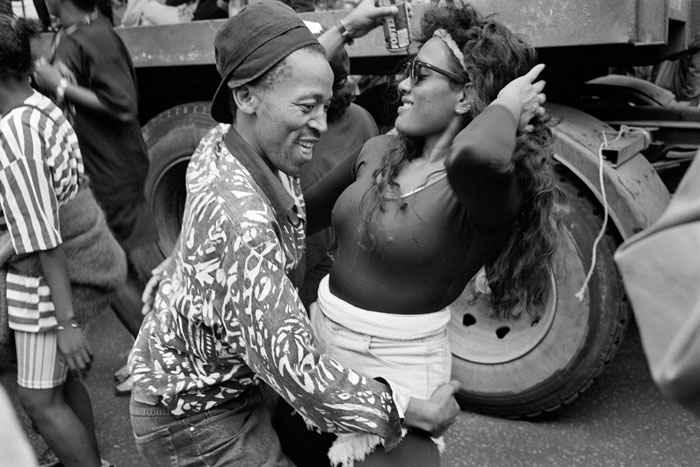

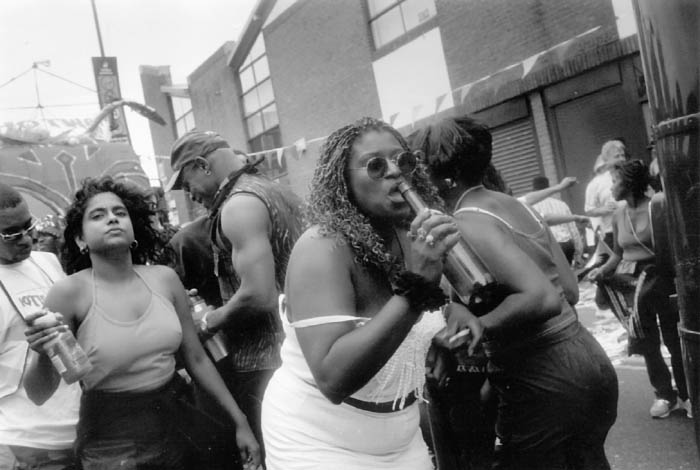
The show continues until 29 Dec at the Barbican Library.
Thanks to Tommy Wong for a write-up of our English Carnival show on Londonist.
Here are another couple of my pictures from the show:



The show continues until 29 Dec at the Barbican Library.
Quite a few have remarked that the recently announced Nikon D3x appears to use the same sensor (Nikon say it isn’t identical, but differences are likely to be small) as the Sony Alpha 900, but while the Sony has a street price of around £1600, the Nikon is expected later in the month for £5,500.
There are of course considerable differences in the camera specifications, but hardly it seems enough to account for anything like that price difference.
Looking at the performance of the Sony Alpha 900, it isn’t a camera that would greatly appeal to me. The Nikon D700 or the D3x have a lot more going for them with their better performance at high ISO. And for those of us who take a lot of pictures, those up to 50Mb RAW files would really eat up card and disk space.
However I’m certainly not going back to an F2. The D300 is still doing pretty well. You can see more videos on the D3x on YouTube – but most are very annoying. The best of a bad lot I’ve found so far is from What Digital Camera magazine.
But the review you really have to see is where the Führer vents his spleen when told the price of the D3x. “Makes me wonder why the hell I went digital, instad of stick to film like Stalin!“
Ghouls, zombies and the undead staggered and lunged along Ramillies Street on my previous visit, sprawling on the roadway of this small street down a short flight of steps from Oxford Street, often referred to – as Photographers’ Gallery director Brett Rogers informed us – as “Piss Alley.”
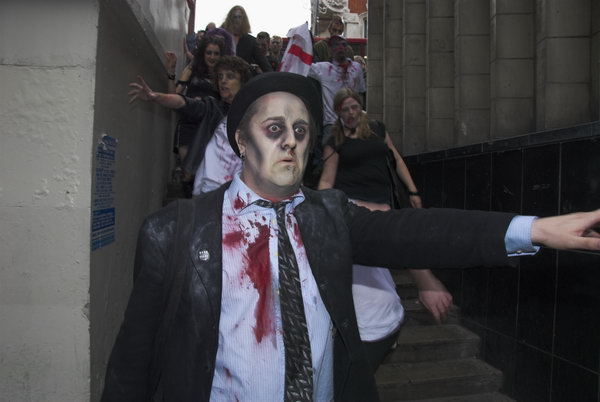
Coming down the steps into Ramillies St
But that was Halloween a couple for years ago, and tonight things in the pristine white space of the temporary home of England’s “flagship photography gallery” were a little quieter, although I was perhaps more apprehensive.
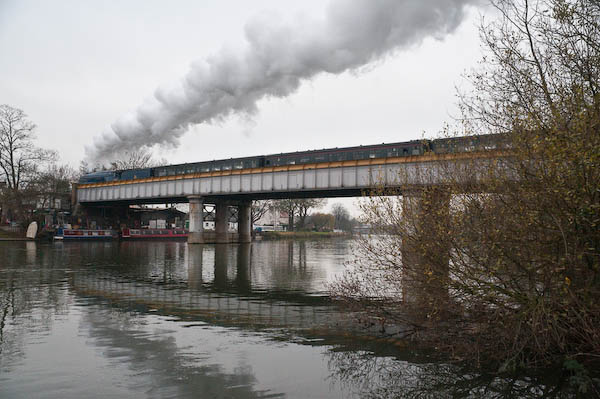
Brett Rogers welcomes us to the gallery
Rogers welcomed us to the new space – opposite the former home of Keith Johnson Photographic, and like its predecessor on the edges of Soho, but this time at its north rather than east – and waxed enthusiastic about the possibilities it presented for a new building to replace the current temporary conversion. Dublin based architects O’Donnell + Tuomey then told us about their early years in London and their plans for a new building, constrained by the small footprint of the site, rising vertically around a lift and stairway, organically (or at least metaphorically) like the branches from the trunk of a mighty oak. (You can read more here – and see a computer graphic view of the new building by clicking on the thumbnail.)

John Tuomey talks about the building as Sheila O’Donnell looks on.
Their presentation was excellent, but I found the futures suggested for the gallery outlined by Rogers rather more chilling, and my doubts were heightened by the work that had been selected for the inaugural showings in this new space.
Like many of those I talked to, I felt that this was a real occasion that should have celebrated English (or British) photography, but it was one that was sadly missed.
I’m old enough to remember Picture Post and its place in lifting the spirits in an age of austerity and rationing, even though in my childhood my family were too poor to buy it. We saw copies at neighbours and friends, read it waiting for a haircut at the barbers, and sometimes people passed on issues when they had read them. Later of course I saw many of its best pictures republished in books, and got to know the work of many of its better photographers, writing features about several of them, including Thurston Hopkins, Grace Robertson, Bert Hardy and Bill Brandt.
It takes great curatorial expertise to mine this rich resource and produce such as turgid, mind-numbing show as was presented on the ground floor of the gallery. All photographers of course have their off-days but on this evidence Picture Post photographers spent most of them – or at least their off-nights – in Soho. But from the evidence we see here it would be difficult to regard Hopkins or Slim Hewitt as anything more than reasonably competent hacks. And Tim Gidal and Kurt Hutton fare little if any better, and we can see that Ken Russell was well-advised to turn to making films.
As the major show for this major British event I would have hoped for a major show by a well-known British (or British-based) photographer – perhaps one of that long list neglected by the gallery over the years (and there were at least half a dozen of them present at the opening) or one of the great historical figures in photography in this country – such as Bill Brandt or Raymond Moore.
Instead we got Katy Grannan, a USAmerican photographer bron in 1969 who studied with Gregory Crewdson, Philip-Lorca diCorcia and Tod Papageorge at Yale (one of the more disappointing highlights mentioned by Rogers was the Deutsche Börse Photography Prize 2009, where Papageorge is a contender with his rather bland images of Central Park, shown at Michael Hoppen in Chelsea earlier this year – but I couldn’t bring myself to review it, as the most interesing thing was that one image was shown upside down – though Taryn Simon is also on the short list for her Photographers’ Gallery Show – one of their best in recent years, but it is hardly a heavyweight list) graduating with an MFA in 1999.
Grannan had her first gallery shows in 1998, and in 2004 she showed work at Arles, exhibited in the Whitney Biennial and won the 2004 Baum Fellowship Award for Emerging American Photographers. In 2005 she got an Aperture award for emerging photographers, and theypublished her ‘Model Americans.‘
Grannan is a photographer whose work I’ve previously written about appreciatively in the past, but I think this show, “The Westerns” does little to enhance her reputation. Large images, empty in every sense, at times vapid, with a few little digs in various directions including an unbelievably bad Edward Weston pastiche. You can read an interesting interview on her earlier work at The Guardian by Melissa Denes.
In that earlier work, published in Model Americans in 2005, she photographed people in their homes and other locations, she worked mainly with strangers (starting to advertise for models in local papers in 1998), coming together for the short time needed for her to arrange them (and sometimes the surroundings) as a stage set on which to photograhp them with her 4×5 camera. The Westerns is the result of a more lengthy collaboration with three people, including two middle-aged transsexuals, and I don’t feel she has managed to sustain the same level of interest and creativity. It might even have been a more interesting work had the three people concerned been more conventional in their life-styles; their somewhat exotic nature makes for too easy a cliche.
Grannan is a photographer for whom size matters, and most of these prints seem to me to be oversize. Her work often appeals far more strongly to me on the web or magazine page than as these large wall prints.
Of course there were a good things on show – including Vanessa Winship’s charming portraits (one of the few stars of this year’s Arles, her pictures are also on show in the Royal Festival Hall as a part of the 2008 World Press Photo.) And on the top floor in the Print Sales area, Picture Post came to the rescue with Bert Hardy‘s delightful evocation of a British summer in his Box Brownie view of two young women perched on the promenade rail at Blackpool. It was an image that stood out glowing from what largely seemed to be an ocean of fashionable mediocrity.
I’d gone to the event in an optimistic mood; I’d thought that perhaps the move to a new building represented the possibility for a new start, a new emphasis on photography. Unfortunately the auguries seem bad, and despite the new premises, the gallery seems destined to remain mired in the same old rut.

At the opening – not much depth of field on the 35mm at f1.4!
As someone who has been a member for around 30 years I find it deeply disappointing that if you want to see photography and a vibrant photographic culture you need to look elsewhere, whether to smaller London galleries such as HOST or by taking a trip to Paris. (see Paris and London: MEP & PG)
Almost 4000 marchers, along with several hundred cyclists, demonstrated in London on Saturday 6 December, marching from Grosvenor Square along Piccadilly, past Trafalgar Square and up Whitehall to a rally at Parliament Square. It was a colourful event, with many in costumes and most carried placards or banners to send a clear message to the UK government that urgent action is needed to secure a future for the planet.
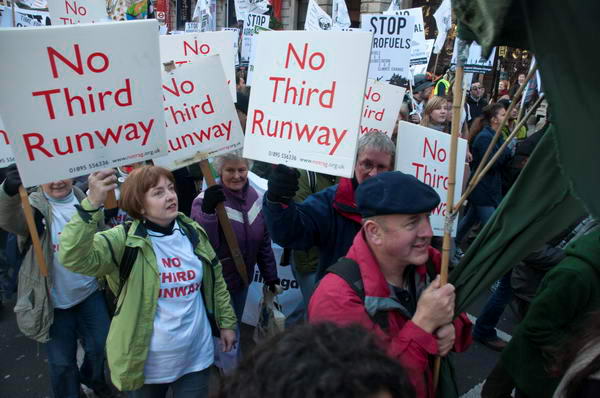
Posters reflected the four major themes – no to coal-fired power stations, no to airport expansion, no to agro-fuels and a big yes to a renewable energy revolution and green jobs – as well as numerous related issues. Campaigners from many groups around the country – such as those opposed to the building of a third runway through homes to the north of Heathrow – made their views felt.
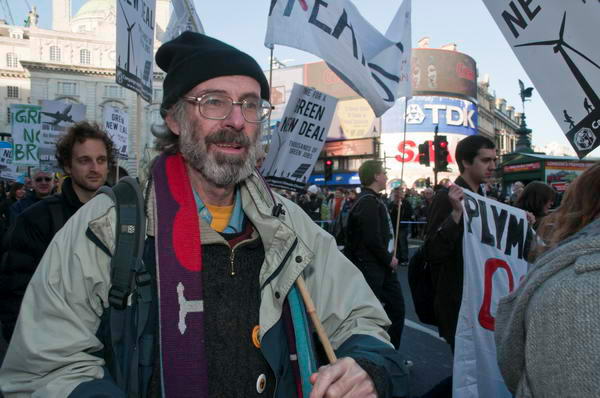
Phil Thornhill, National Coordinator of the Campaign Against Climate Change
The march, organised by the Campaign Against Climate Change, was timed to coincide with the UN Climate Talks in Poznan, Poland, and was part of a Global Day of Action with events in 70 countries around the world. There was a large police presence, with more Forward Intelligence Teams than I’ve seen at a single event before, but despite a few provocative actions – including what seemed some arbitrary “stop and searches” and photographing a working photographer in defiance of the guidelines – the event remained peaceful and good-natured.
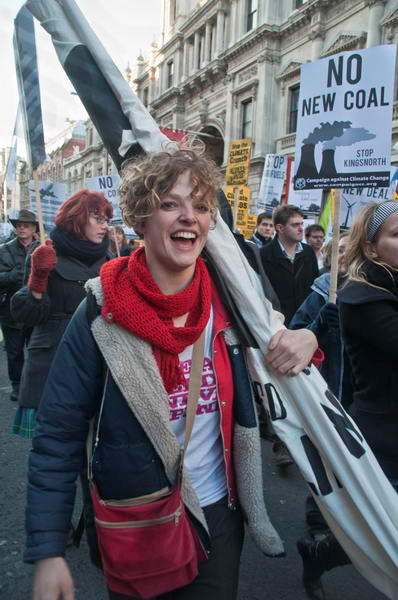
Tasmin Osmond brought the Suffragette Banner from the ‘Climate Rush’ in October.
Environmental direct action continued on Monday morning, when around 50 activists from Plane Stupid cut through the fence at London Stanstead Airport and staged a lock-on. It was around 5 hours before police were able to remove them and the airport could be re-opened. Very many more such actions – but on a larger scale – are expected should the government reject environmental advice and press ahead with plans to build a new third runway at London Heathrow.
More pictures and more about the Climate Change March on My London Diary.
There are times when you walk into a gallery and look at the work on the wall and somehow every seems right and in place. It isn’t necessarily great work, but something that hangs together, that has a consistency of feeling and a strong sense of having been created by a thinking and feeling person able to express themselves clearly.
I felt that strongly when I walked into Galerie Claire Corcia on the rue Saint-Martin and began to look at the black and white images of Louise Narbo. Born in Algeria, she came to Paris where she still lives in the 1960s to continue her studies, training to become a pyschoanalyst. It didn’t surprise me to learn this after seeing her work which had already impressed me as being very much concerned with states of mind.
The work on show covered a wider range than on the gallery site, and you can see more on Narbo’s own site. There are several series of pictures, along with some short texts about the projects and about her and her photographic interests. Many of the pictures I saw at the gallery are on that site, although I think some I particularly liked made recently in her Vincennes flat are not.
Narbo has been taking photographs for over 30 years, and had her first personal show in 1982. One of the series I liked most on her site, “Ce qui ne s’ecrit pas” was shown in 1989. Although all the series had images that I liked, this seemed to work better as a series.
She currently has another show, Hiver Fertile, pictures from the Bois de Vincennes at the eastern edge of Paris, close to where she lives, on show in Vincennes until Dec 20, 2008. You can see some other work from the Bois de Vincennes on her site.
Jacques Vauclair (1926-99) started working in photography at Studio Harcourt in 1946. Set up to meet the needs of the press in 1934, the studio had developed into a leading portrait studio with a fairly distinctive film-style lighting and posing. It’s “trademark style” continues in use to the present day by the studio, still offering its services. To me it recalls the worst of Hollywood photography of the era in which it is founded.
You can find the site easily on Google, by typing in ‘Studio Harcourt’. As well as some pictures it contains one of the most restrictive ‘Legal Notices’ I’ve seen on the web which probably means I’m not even allowed to tell you about it or hint at its existence and certainly can’t link to it. Google are big enough to ignore such things – as they do.
Like much film lighting of the period, it was done to make people look as if they were in a film, very much in the spotlight. To my eyes, used to a more realist approach it seems impossibly stagey and false, incredibly dated. Light should generally be sympathetic and help to describe the subject, not overpower it, and certainly not to the extent that the actual subject becomes almost immaterial.
Vauclair, to his credit, didn’t quite seem to fit Harcourt, though it was ten years before he left to set up Studio Vauclair, next to the famous Olympia concert hall. For the next five years or so he was the photographer to be photographed by in Paris, particularly for actors, actresses, singers (even then they didn’t call female singers singesses) and the young unknowns who became a part of the French ‘New Wave’ cinema.
Although many of the stars he photographed may be better known in France, even I’ve head of some of them, including figures such as Charles Trenet, Charles Aznavour, Jacques Brel and Georges Brassens, Jean Marais, Catherine Deneuve and Jean-Pierre Léaud.
Looking through the large cellar gallery of Le Centre IRIS, its walls covered with images – or the book that accompanies the show – its hard not to be impressed by the sheer volume. There are some interesting portraits, particularly of the singers, but too many are let down by either the lighting of the printing I think many were modern prints from his negatives) or both. Frankly there were quite a few images on show that had a student brought them out of the darkroom to show me I would have made a few suggestions and sent them back to try and do better. But then perhaps I don’t understand his version of that trademark style.
For Vauclair, the time was the most beautiful years of his life, and it was his luck to mix with the greatest artists of this unique era. It gave him great professional and personal satisfaction. But eventually gave up professional photography to pursue a second very successful career as a songwriter. His work in this show is valuable as a fine record of the period and milieu in which he worked and the way he lit and took pictures is also very much of its time. But I do hope there are no photographers out there today who think it a style worth emulation.
There are times when it’s hard to decide how to cover a story. Although when I got an e-mail about the latest event organised by the Space Hijackers it looked as if it might be interesting, I could see there might be practical difficulties in covering it.
They had decided to hold what they called “the restyling fashion mash-up event of the year” inside one of the larger shops on London’s busiest shopping street, Oxford St. And of course to do so without permission. Although I wasn’t sure about how the store would react to this event, I was pretty clear about one thing – they would not be happy with photographers taking pictures.
So I went along hoping that something interesting would happen outside the shop. I did recognise a few people going in from having taken pictures at earlier events, and there were a couple of police standing around watching the front of the shop, but otherwise nothing was happening. So eventually I decided to go inside and take a look.
There a found a group of people taking off various items of clothing and exchanging them with others on the shop floor, watched by rather a lot of security men and a few police. And as expected, almost as soon as I started photographing I too was surrounded by large guys dressed in black telling me I couldn’t take pictures. Since thespace in front of my lens was by then filled at short range by large black clad shapes, there wasn’t a lot of point in trying!
All of them were polite to me (as I of course was to them) but our conversation wasn’t going to get me anywhere, and so I walked out of the store (with one of the security men following me until I left the premises.) I was rather surprised that I hadn’t even been asked to leave, just told to stop taking pictures.
Two other photographers who had come to cover the event were treated a little less politely, getting pushed around and one woman photographer was actually physically thrown out of the store – though I was just too far away to get a picture as this happened. They’ve also been banned from Topshop, though I don’t think either will be too worried by this.
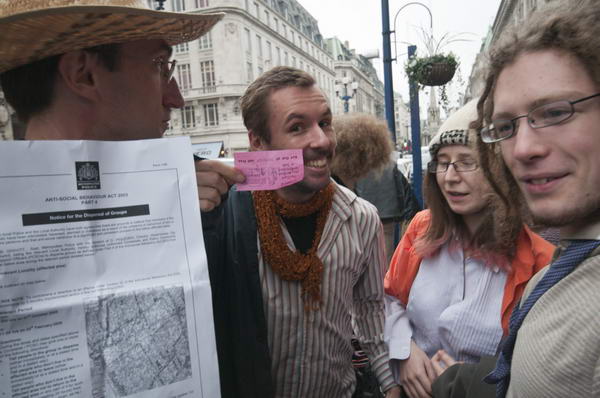
ASBO notice and Space Highjackers pink “Get out of Topshop Jail Free” card
The demonstration, which continued on the pavement outside the shop after those taking part were escorted out of the side door, was of course a protest against consumerism and the relentless pressure on people to buy things that they don’t really need that is central to our society. One of them was served with a Notice for the Dispersal of Groups under the Anti-social Behaviour Act. This didn’t seem appropriate for the protest in the store as it seems only to apply in public places and outside there seemed to be no evidence of “members of the public being intimidated, harassed, alarmed or distressed.” Those few who noticed what was happening seemed either slightly puzzled or mildly amused, though one or two stopped to join in or take photographs.
More about the protest and more pictures on My London Diary.
Increasingly in England it is getting more problematic to take photographs on the street, with increasing suspicion from both police and public. And of course the police advertising campaign suggesting anyone with a camera was a terrorist suspect and should be reported to them didn’t help any.
Our right in the UK to take photographs in public places has recently been affirmed again by the government. But at the same time they also seem to be one of the parties busily eroding it, with new legislation, and guidance to the police. Judges (and one judge in particular) seem also to have recently tipped the balance in favouring rights to privacy (at least of celebrities) in public places over the rights of photographers and the public at large.
Our right to photograph is also diminished by the increasing privatisation of public spaces. More and more areas of cities to which the public have access are becoming privately owned. Quite large areas of the City of London which appear to most users as public streets which now actually private property, and so too are vast areas such as Canary Wharf. Many of London’s parks are also in private hands – of the Crown. Although you may often get away with taking pictures, you can also, as I’ve found on several occasions, be stopped from doing so.
Even some areas remaining in public hands, such as Trafalgar Square, are covered by by-laws which restrict photography, and although their intention was usually to get commercial photographers to pay for their use of locations, other photographers are at times stopped.
In France, the law relating to photographing people in public seems to be fairly similar to that in the UK. If you can read French, the FreeLens site is a useful source of information on the various laws that restrict the activities of photojournalists in France – and they also produce a useful booklet you can download, “Photographe Presse Mode D’Emploi“, essential reading for freelances (pigistes) working there.
This makes clear that people have no rights to their image under the code of Civil Law, but they do have a right of privacy, which has been the subject of interpretation by the courts. As in the UK, in general you can publish pictures of people in public in the press without needing their permission. However it is important to treat the subject suitably and to caption pictures accurately.
Similar rules apply to property that is on public view – so long as it does not amount to a breach of privacy, pictures can be published without the need for authorisation. However for commercial use, if people or property are an important part of an image, you may have a problem, although it would be necessary for those wishing to make a claim against you to establish an actual cause for complaint.
A difference from the law – if not practice – in the UK is that journalists may photograph freely in the Metro and at railway stations, although videoing or filming needs permission.
French law also forbids publishing recognisable pictures of police doing their duty, except during demonstrations. One of the latest UK laws, the Counter-Terrorism Act, 2008 which received royal assent recently means that photographing a police officer here might also result in a lengthy jail sentence.
The position of artists is perhaps less clear than that of journalists. Certainly in the past there has been considerably more important placed on the rights of individuals over their appearance in France than in the UK or USA.
Which brings me (at last!) on to the the work of Lin Delpierre (b 1962) on show in rue Quincampoix in Paris at the Galerie Cour Carree in November.
‘Passantes‘ shows women walking by the photographer on the streets (the web site has series showing women from Bombay, Buenos Aires and Peking taken on medium format as well as groups of men on the street in Calcutta taken with 5×4 and other work.) As the text makes clear, Delpierre has travelled the world to photograph women in cities, including Rome, Moscow and Barcelona – as well as Paris.
The pictures are taken without permission and apparently often without the knowledge of the women involved, although some seem to be reacting to the presence of the photographer – either by staring or looking away.
Taken with a square format camera, Delpierre normally frames the figures fairly centrally, from perhaps 5 feet ot sometimes a little further away, working perhaps from waist level or slightly higher and seldom if ever showing them below knee level – but with quite a bit a space in the image above their heads. Mostly the subjects are young, and mostly they are at least fairly attractive.
I was in part reminded of Gary Winogrand’s most controversial book ‘Women Are Beautiful‘, although Delpierre’s work doesn’t show the same preoccupation – most of his subjects lack the sexuality that attracted Winogrand, so obviously in the grip of a mammary obsession.
The medium format also cuts down depth of field, and in some images this amounts to almost a dislocation of the subject from background, almost a cardboard cut-out effect, exaggerated on the web site by over-sharpening. At times he seems to catch women as they step into pools of light, and while on the web this gives the appearance of added flash, the lighting on the works on show appeared more natural.
One report I read about the show suggested that Delpierre’s work was original in that he worked at a close distance. Hardly so, since many street photographers have prowled for ages with their lenses pre-focussed at a similar distance – including me. Some of us have often mixed black and white with colour also, as he does in his triptychs.
I have to admit to liking Winogrand’s work, although (or because?) it sometimes makes me feel as if I am standing on the street and giving a wolf-whistle at the girls who go by. Not that this was ever the kind of behaviour I indulged in (though I had friends who did.) His pictures have a directness and an openness whereas in fornt of some of Delpierre’s I feel more of a voyeur. This perhaps reflects a different sensibility between the French and English.
I asked if the photographer thought photographing on the street in this way had any problems, and the answer was that there were none – it was a way of working that had a long pedigree in photography and there were no legal or moral issues involved.
To an extent I agree. These are people in public, and their actions are visible to any of us who share their space. Showing them in a photograph doesn’t really alter things, but the act of taking the photograph may. Many women may well feel they are being harassed by the photographer – and were they to see their photograph being exhibited might well feel aggrieved.
I would have been happier if I could have seen a real reason – perhaps documentary – for these images on the street. They reminded me a little of a fascinating series of men and women walking along Sutton High Street around 1930, published in Photographers’ London 1839-45. Nothing seems to be known about the photographer or his reason for making the images, but they are now a fascinating record of their times.
Delpierre’s women, particularly in their clothing, do indicated geographical differences (and the season and weather) but although they were technically fine, I wasn’t too sure I was really able to see the same kind of interest in them, and I don’t think it was the photographer’s intention. But perhaps in 75 years time they too will look different.
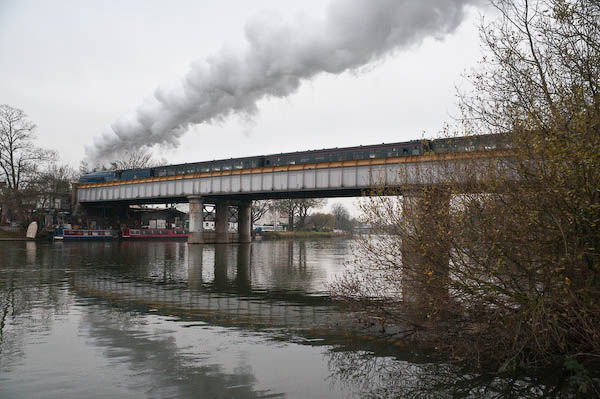
Sir Nigel Gresley hauls the steam special over the River Thames at Staines
I’m not a railway photographer, and my main interest in trains is in using them to get places. So I had considerable sympathy with the woman I had a short conversation with on the riverbank after I had photographed the steam special going across the bridge over the River Thames. She felt it was old-fashioned and far too noisy and would have preferred to see a modern train on our lines.
We have seen considerable modernisation on the railway since I’ve moved to Staines, with several generations of new trains, complete replacement of track with long sections of welded rails and more. So far this has resulted in a considerably slower and less frequent service to London – and of course in costs that have increased considerably above inflation.
Actual travel times have increased – the so-called “fast” services now taking around 20% longer than they used to – though it is useful that they now stop at Clapham Junction rather than racing through it.
Actual travel times are longer still. In the old days you could arrive at the station for a train that was timetabled at 10.23 at that time or even a few seconds later, jumping on it even as it started to pull out and buy your ticket from the guard – or at your destination. Now you need to allow at least 5 minutes to buy a ticket – longer at busy times (and if there is an international on at Twickenham it can take 30 minutes). You may then have a short queue to get through the newly installed ticket gates, and the train doors are likely to be locked half a minute before the scheduled departure time. All in all, you need to allow almost half as long again for the journey to Waterloo.
But also for me, the sound of a steam engine is still exciting. It takes me back to my occasional bike rides up to Southall and that long footbridge (closed last time I was there) over the tracks along which Kings and Castles thundered at speed. The sound and the steam and smoke all add up to a great feeling of power. And the two places where I photographed are only a couple of minutes on a bike from my home!
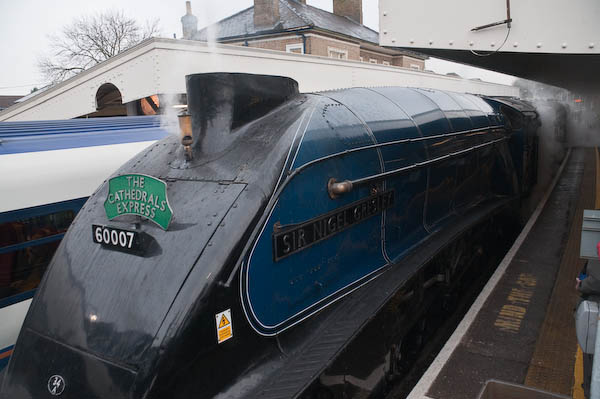
The engine hauling ‘The Cathedrals Express’ was ‘Sir Nigel Gresley‘, the 100th Gresley Pacific, built in 1937 by the London and North Eastern Railway who honoured the designer of the class by giving the locomotive his name, and now owned and maintained by a devoted charity.

I photographed it coming into Staines, along with around 50 rail enthusiasts who had also come to watch. It stopped in Staines for a few minutes to pick up passengers for an expensive day out. I got on my bike and cycled down to the River Thames to take some pictures as the train swept across the bridge. Here I was the only photographer.
Ricky Bishop was a passenger in a friend’s car, driving through the back streets of Brixton, London on a Thursday afternoon, 22 November, 2001. For reasons that have never become clear, police decided he was suspicious (being a young black male seems often to be a good enough reason, and the fact he was in a car with a white man may have added to their concerns) and decided to stop the car and take the two along to Brixton Police Station for questioning.
Four hours later, a healthy young 25 year old black man was dead. Bishop’s family and friends allege he was assaulted by police, and that they held him down and failed to giv e medical assistance when he had a heart attack. The inquest seems largely to have served to lay bare inconsistencies in the police account, and the jury were denied the opportunity of bringing in a verdict that would have blamed the police for his death – as is also happening in the current case of Jean Charles de Menezes.
His family and many members of the community want to see justice done, not just in this case but in many others. At the anniversary march in Brixton this year, two other men were also remembered, Derek Bennett, shot in the back by police as he held a novelty gun-shaped cigarette lighter in Brixton in 2001, and Sean Rigg, who died after being taken ill in police custody in Brixton Police Station on Thursday 21 August 2008.
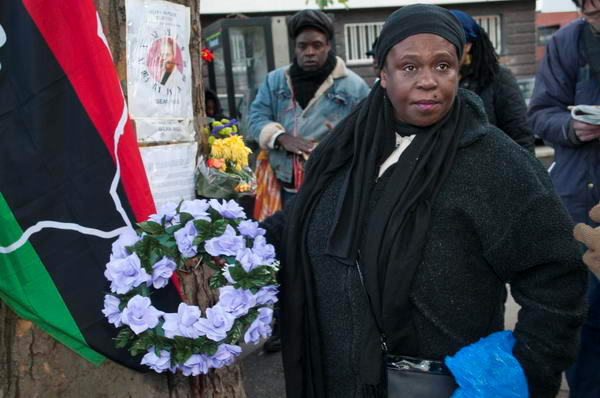
You can see more about the march and rally outside Brixton Police Station on My London Diary. Elsewhere on Current TV there is also a short video by Jason Parkinson which includes much of Ruth Kimathi’s statement about the Bishop case.